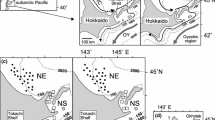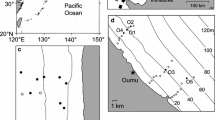Abstract
We examined factors affecting the vertical distribution of juvenile walleye pollock during “the second critical period” (i.e. the transition period of prey size) in and around Funka Bay, Hokkaido, Japan. During the day, small juveniles (<30 mm) were distributed mainly in shallow, warm, and low-salinity water within the bay, whereas larger ones (≥30 mm) occurred in deeper, cold and saline water. During the night, the large juveniles migrated to shallower depths. Outside the bay, small- and large-sized juveniles were distributed in water masses of similar physical properties during the daytime, whereas during the nighttime, most of the juveniles moved to shallower depth, and some juveniles dived to deeper water mass. Dietary analysis revealed that large juveniles fed on large copepods (≥0.5 mm in body width) more than small juveniles did. The composition of zooplankton in our survey area showed that large-sized copepods often occurred in deeper saline water. From these results, there is a possibility that juvenile pollock inside and outside Funka Bay occupied different water masses preferable for each feeding advantage.







Similar content being viewed by others
References
Fisheries Agency, Fisheries Research Agency of Japan (2012) Marine fisheries stock assessment and evaluation for Japanese waters. Fisheries Agency and Fisheries Research Agency of Japan, Tokyo (in Japanese)
Funamoto T (2007) Temperature-dependant stock-recruitment model for walleye pollock (Theragra chalcogramma) around northern Japan. Fish Oceanogr 16:515–525
Hollowed AB, Bond NA, Wilderbuer TK, Stockhausen WT, A’mar ZT, Beamish RJ, Overland JE, Schirripa MJ (2009) A framework for modelling fish and shellfish responses to future climate change. ICES J Mar Sci 66:1584–1594
Fisheries Research Agency, Japan (2009) The grand design of fisheries and resources management in Japan: final report. Fisheries Research Agency, Japan, Yokohama
Maeda T, Nakatani T, Takahashi T, Ueno M (1979) Transport and migration of pollock larvae in coastal waters. Bull Jpn Soc Fish Oceanogr 34:81–85 (in Japanese)
Nakatani T, Maeda T (1987) Distribution and movement of walleye pollock larvae Theragra chalcogramma in FB and adjacent waters, Hokkaido. Nippon Suisan Gakkaishi 53:1585–1591 (in Japanese with English abstract)
Shimizu M, Isoda Y (1997) The transport process of walleye pollock eggs into FB in winter. Bull Jpn Soc Fish Oceanogr 61:134–143 (in Japanese with English abstract)
Nishimura A, Hamatsu T, Shida O, Mihara I, Muto T (2007) Interannual variability in hatching period and early growth of juvenile walleye pollock, Theragra chalcogramma, in the Pacific coastal area of Hokkaido. Fish Oceanogr 16:229–239
Nakatani T, Sugimoto K, Takatsu T, Takahashi T (2003) Environmental factors in FB, Hokkaido, affecting the year class strength of walleye pollock, Theragra chalcogramma. Bull Jpn Soc Fish Oceanogr 67:23–28 (in Japanese with English abstract)
Coyle KO, Eisner LB, Mueter FJ, Pinchuk AI, Janout MA, Cieciel KD, Farley EV, Andrews AG (2011) Climate change in the southeastern Bering Sea: impacts on pollock stocks and implications for the oscillating control hypothesis. Fish Oceanogr 20:139–156
Bailey KM (1989) Interaction between the vertical distribution of juvenile walleye pollock Theragra chalcogramma in the eastern Bering Sea, and cannibalism. Mar Ecol Prog Ser 53:205–213
Olla BL, Davis MW (1990) Behavioral responses of juvenile walleye pollock Theragra chalcogramma Pallas to light, thermoclines and food: possible role in vertical distribution. J Exp Mar Biol Ecol 135:59–68
Sogard SM, Olla BL (1993) Effects of light, thermoclines and predator presence on vertical distribution and behavioral interactions of juvenile walleye pollock, Theragra chalcogramma Pallas. J Exp Mar Biol Ecol 167:179–195
Sogard SM, Olla BL (1996) Diel patterns of behavior in juvenile walleye pollock, Theragra chalcogramma. Environ Biol Fish 47:379–386
Honda S, Oshima T, Nishimura A, Hattori T (2004) Movement of walleye pollock, Theragra chalcogramma, from a spawning ground to a nursery ground along the Pacific coast of Hokkaido, Japan. Fish Oceanogr 13:84–98
Kawauchi Y, Shida O, Okumura H, Tojo N, Yasuma H, Miyashita K (2011) Vertical distribution of walleye pollock juveniles before and after the period of transition for feeding in FB, Hokkaido, Japan. J Mar Sci Tech Taiwan 19:279–286
Schabetsberger R, Brodeur RD, Ciannelli L, Napp JM, Swartzman GL (2000) Diel vertical migration and interaction of zooplankton and juvenile walleye pollock (Theragra chalcogramma) at a frontal region near the Pribilof Islands, Bering Sea. ICES J Mar Sci 57:1283–1295
Yamaguchi A, Ikeda T, Shiga N (1998) Population structure and life cycle of Pseudocalanus minutus and Pseudocalanus newmani (Copepoda: Calanoida) in Toyama Bay, southern Japan Sea. Plankton Biol Ecol 45:183–193
Seki J, Shimizu I (1998) Diel migration of zooplankton and feeding behavior of juvenile chum salmon in the central Pacific coast of Hokkaido (in Japanese with English abstract). Bull National Salmon Resources Center 1:13–27
Kondoh H, Ikeda K, Koizumi T, Imada M, Yoshida S (2003) Estimation of the distribution of the population density of Sika deer (Cervus nippon) by applying the inverse distance weighted interpolation model (in Japanese with English abstract). Kyushu J For Res 56:109–112
Wood SN (2006) Generalized additive models: an introduction with R. Chapman & Hall, Boca Raton
Brodeur RD (1998) In situ observations of the association between juvenile fishes and scyphomedusae in the Bering Sea. Mar Ecol Prog Ser 163:11–20
Sogard SM, Olla BL (1996) Food deprivation affects vertical distribution and activity of a marine fish in a thermal gradient: potential energy-conserving mechanism. Mar Ecol Prog Ser 133:43–55
Lang GM, Brodeur RD, Napp JM, Schabetsberger R (2000) Variation in groundfish predation on juvenile walleye pollock relative to hydrographic structure near the Pribilof Islands, Alaska. ICES J Mar Sci 57:265–271
Hayase S, Hamai I (1974) Studies on feeding Habitats of three flatfishes, Cleisthenes pinetorum herzensteini (Schmidt), Hippoglossoides dubius (Schmidt) and Glyptocephalus stelleri (Schmidt). Bull Fish Hokkiado Univ 25:82–99
Yamaguchi A, Shiga N (1997) Vertical distributions and life cycles of Pseudocalanus minutus and P. newmani (Copepoda; Calanoida) off Cape Esan. Bull Plankton Soc Japan 44:11–20 (in Japanese with English abstract)
Nakatani T, Maeda T (1981) Transport process of Alaskan pollock eggs in FB and the adjacent waters, Hokkaido. Nippon Suisan Gakkaishi 47:1115–1118
Acknowledgments
We thank the crews of R/V Ushio-maru and R/V Kinsei-maru for their cooperation in the surveys. We also thank Dr. Shida of Central Fisheries Research Institute, Hokkaido Research Organization, Dr. Mukai, Dr. Yamamoto, Mr. Iwamori, and students in the LaMECA at Hokkaido University for their valuable comments and help. This study was partly supported by grants-in-aid for scientific research from the Japan Society for the Promotion of Science (JSPS) and from the Fisheries Agency of Japan.
Author information
Authors and Affiliations
Corresponding author
Additional information
This article is sponsored by the Fisheries Research Agency, Yokohama, Japan.
Rights and permissions
About this article
Cite this article
Kawauchi, Y., Chimura, M., Mutoh, T. et al. Effect of environmental factors and prey species on daytime and nighttime vertical distribution of juvenile walleye pollock in and around Funka Bay. Fish Sci 80, 139–149 (2014). https://doi.org/10.1007/s12562-014-0718-x
Received:
Accepted:
Published:
Issue Date:
DOI: https://doi.org/10.1007/s12562-014-0718-x




